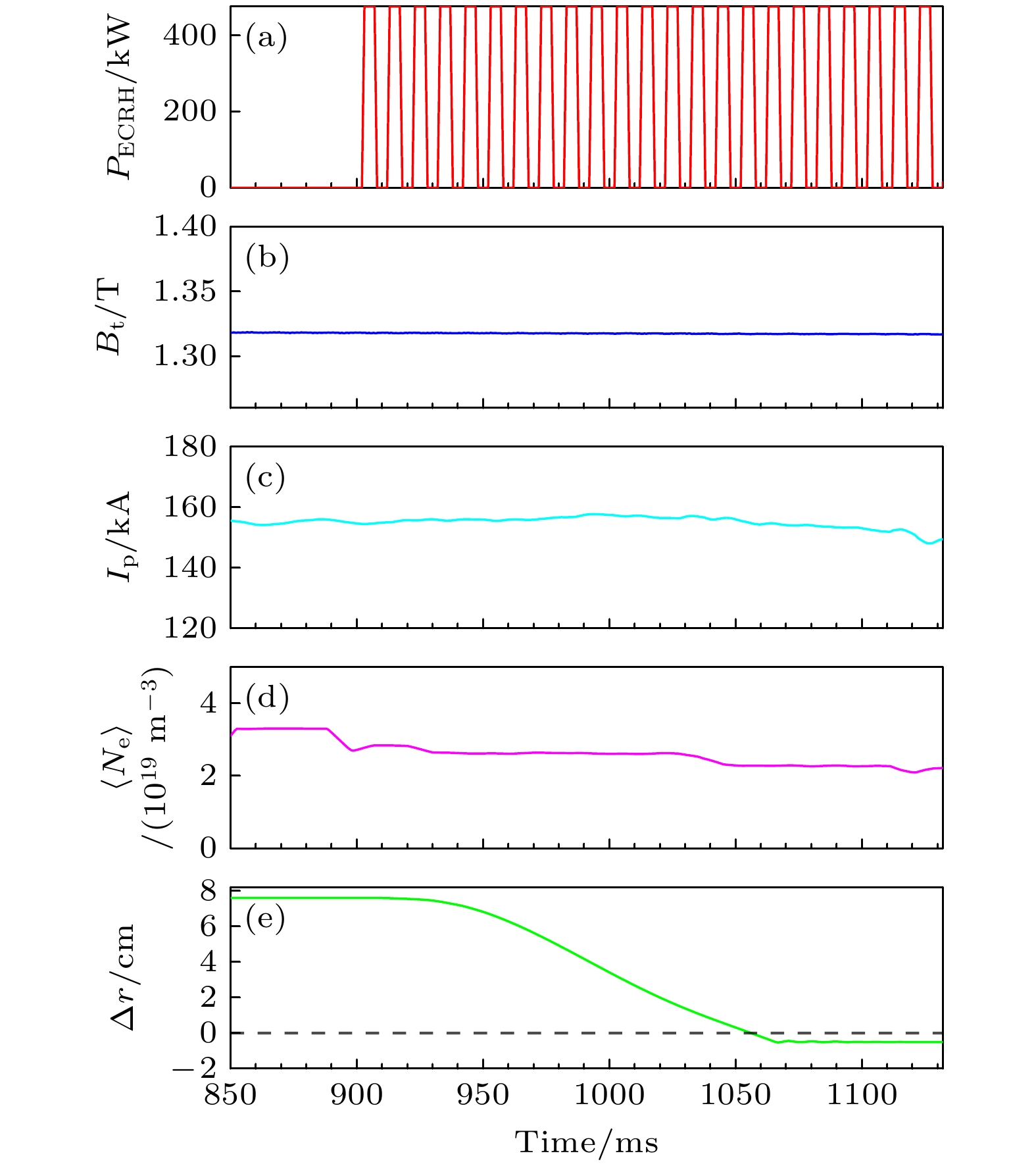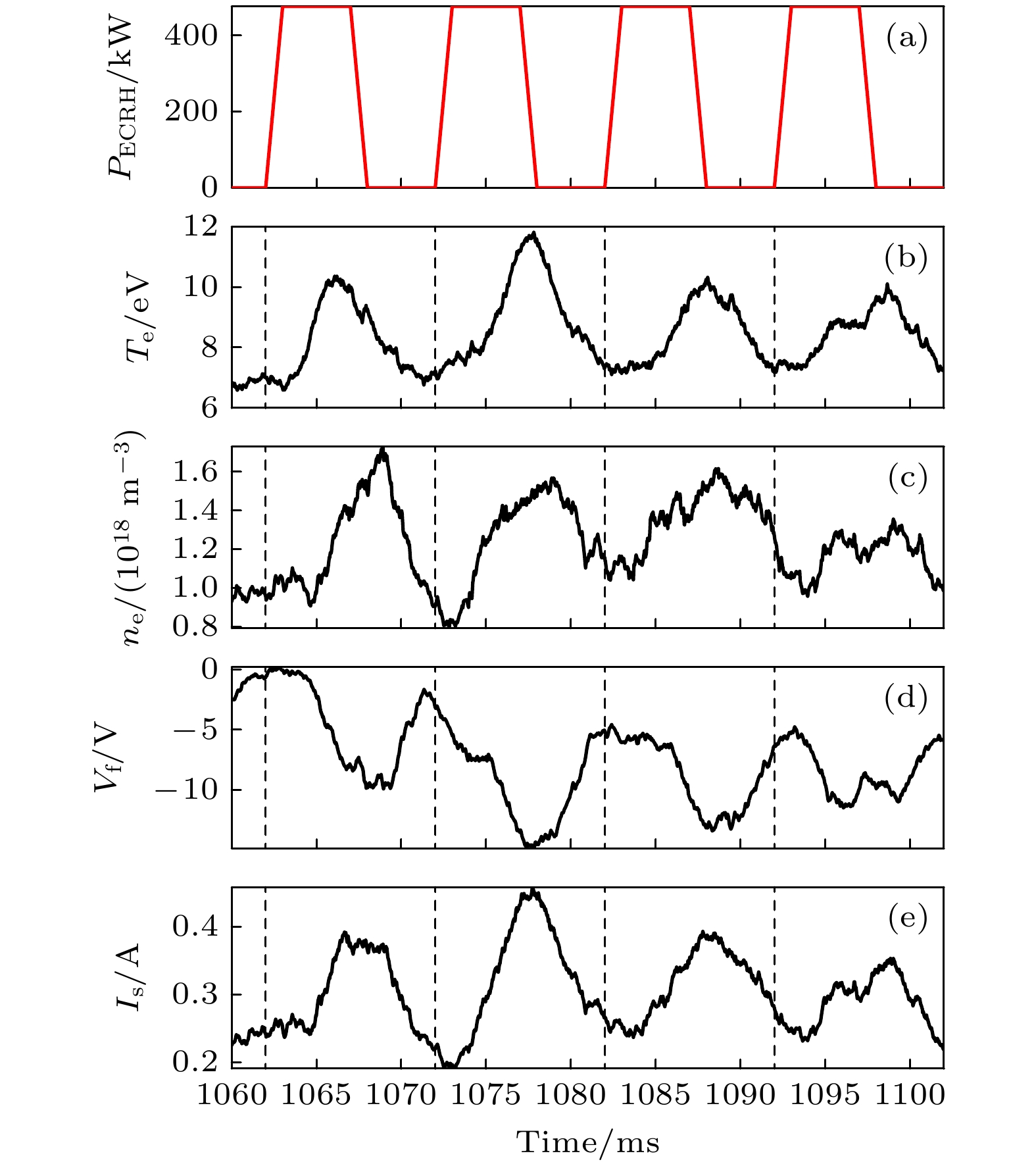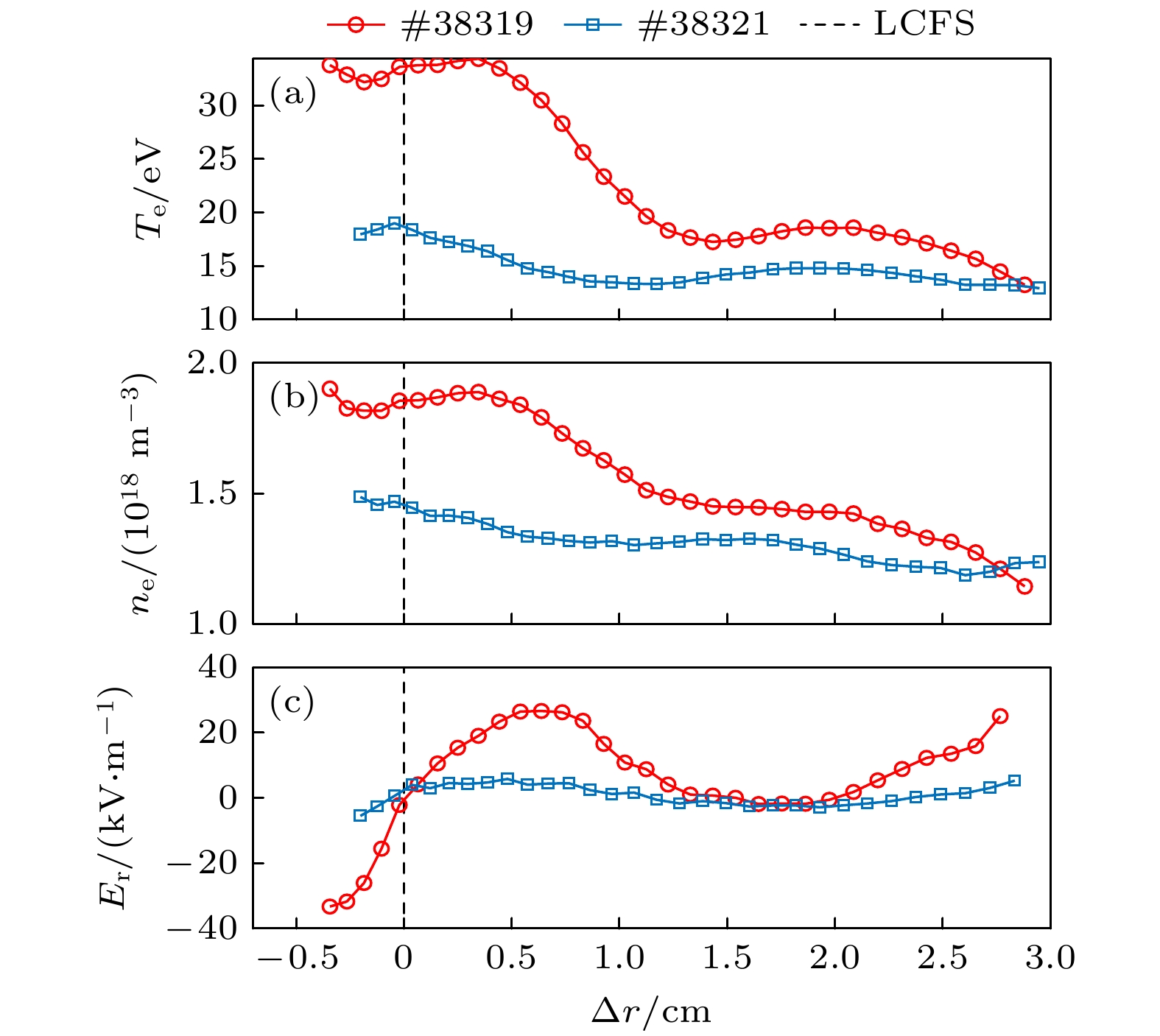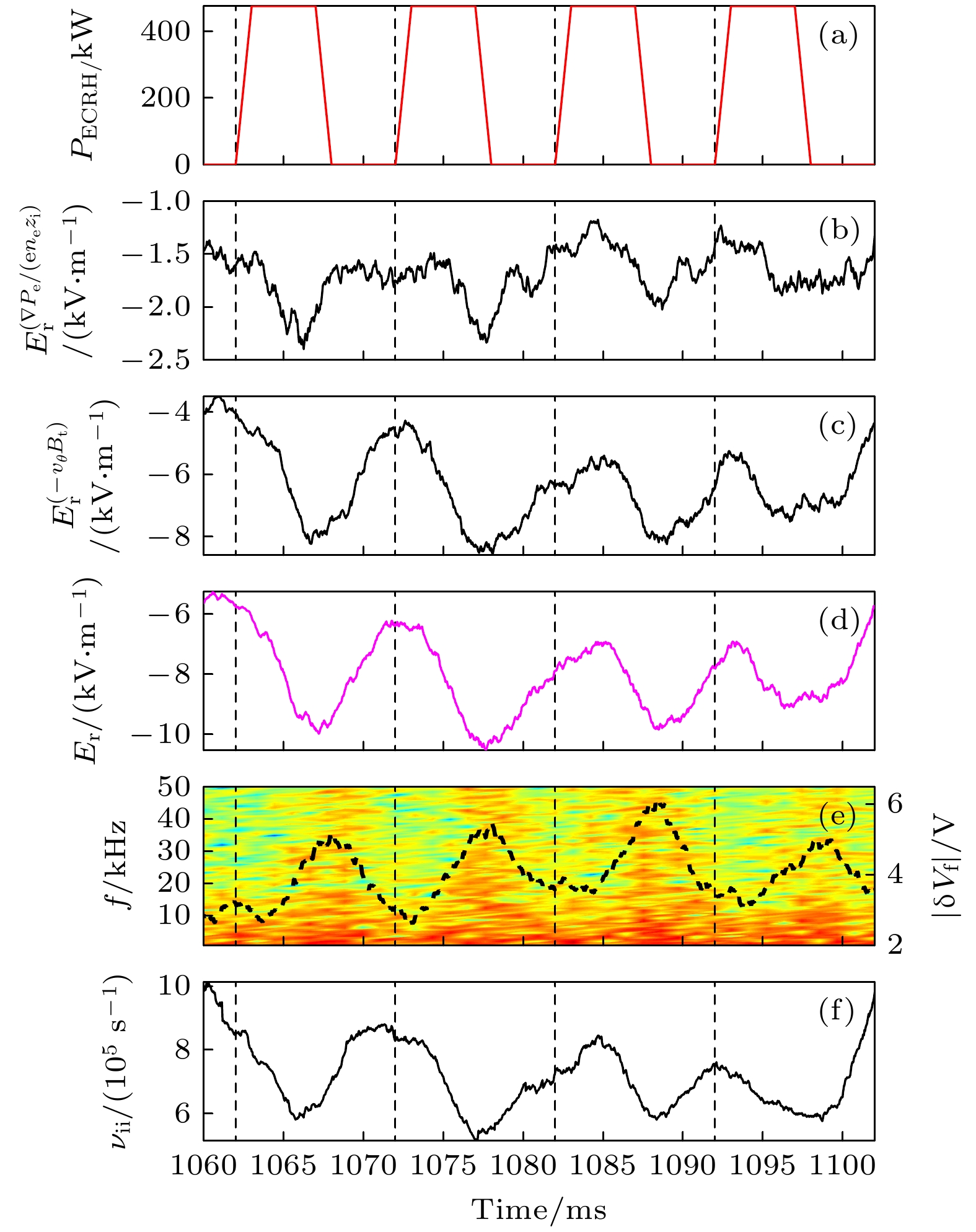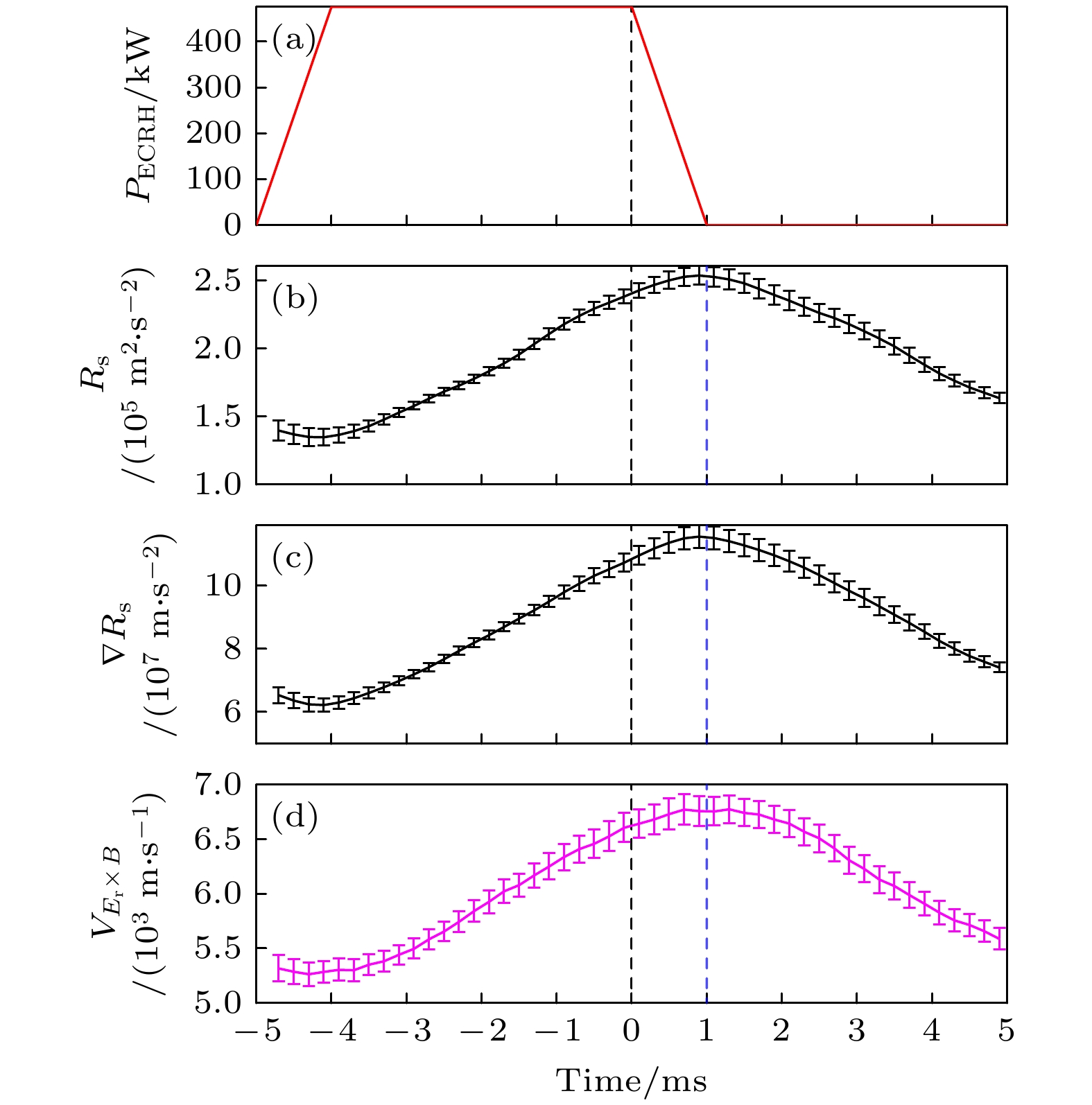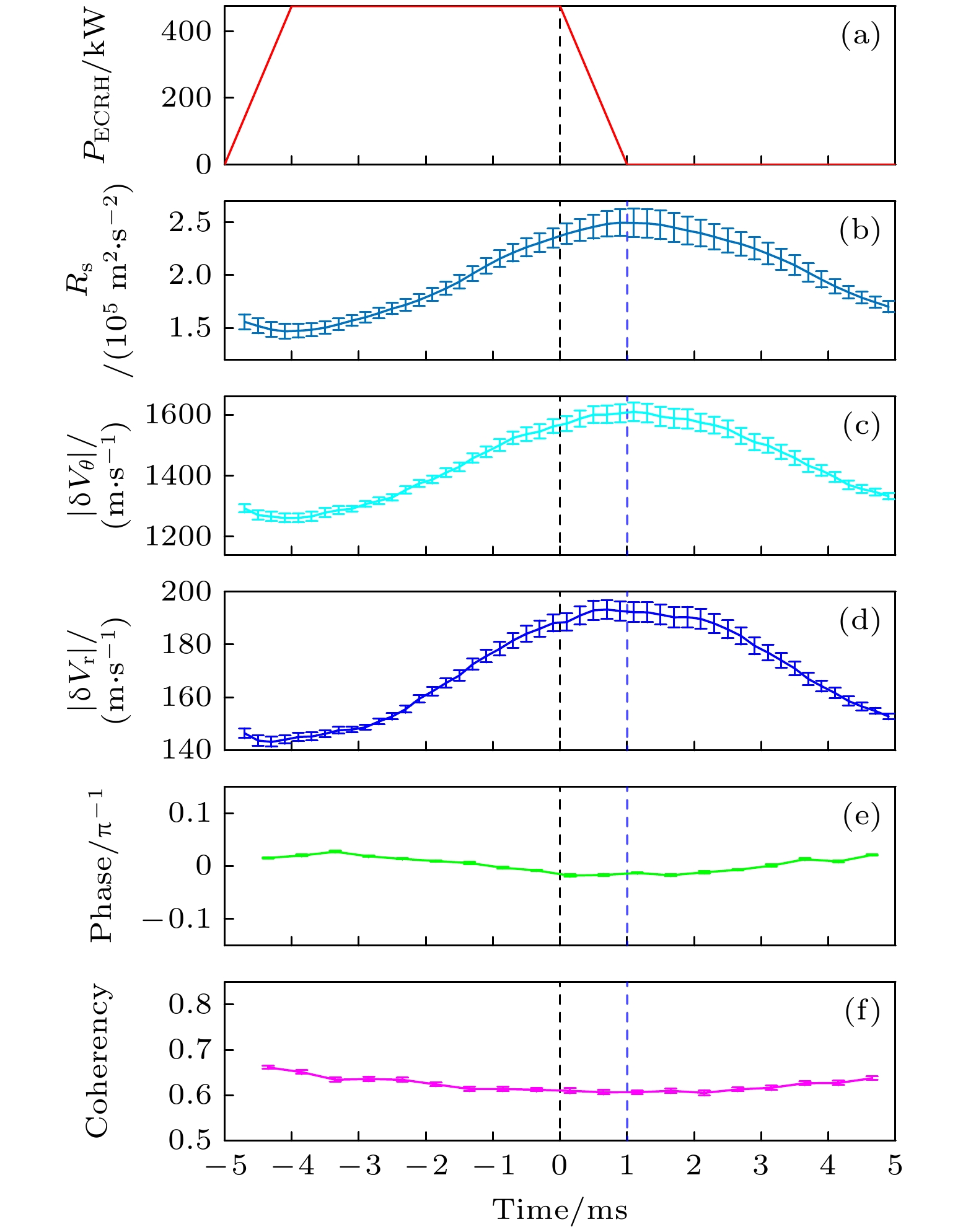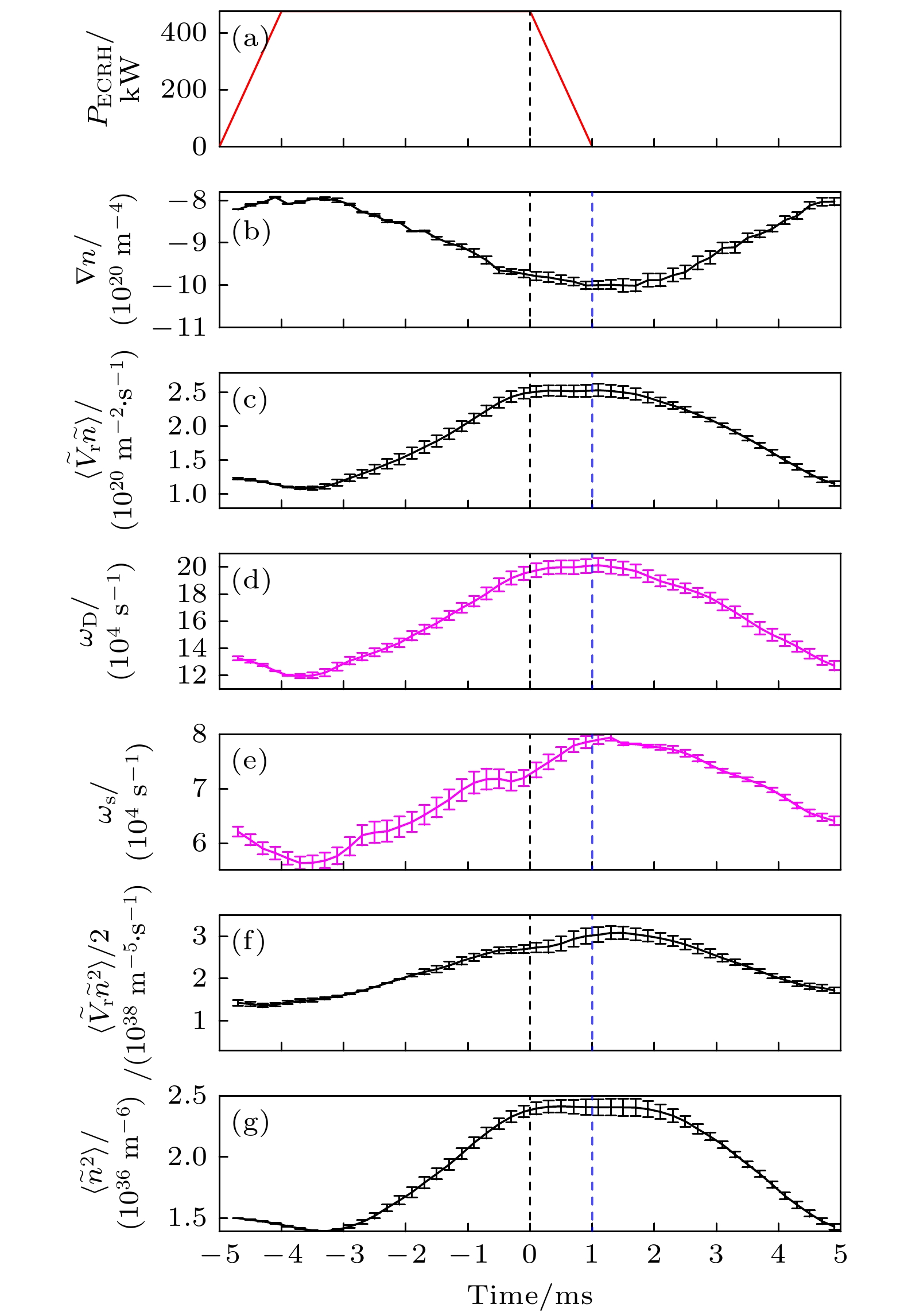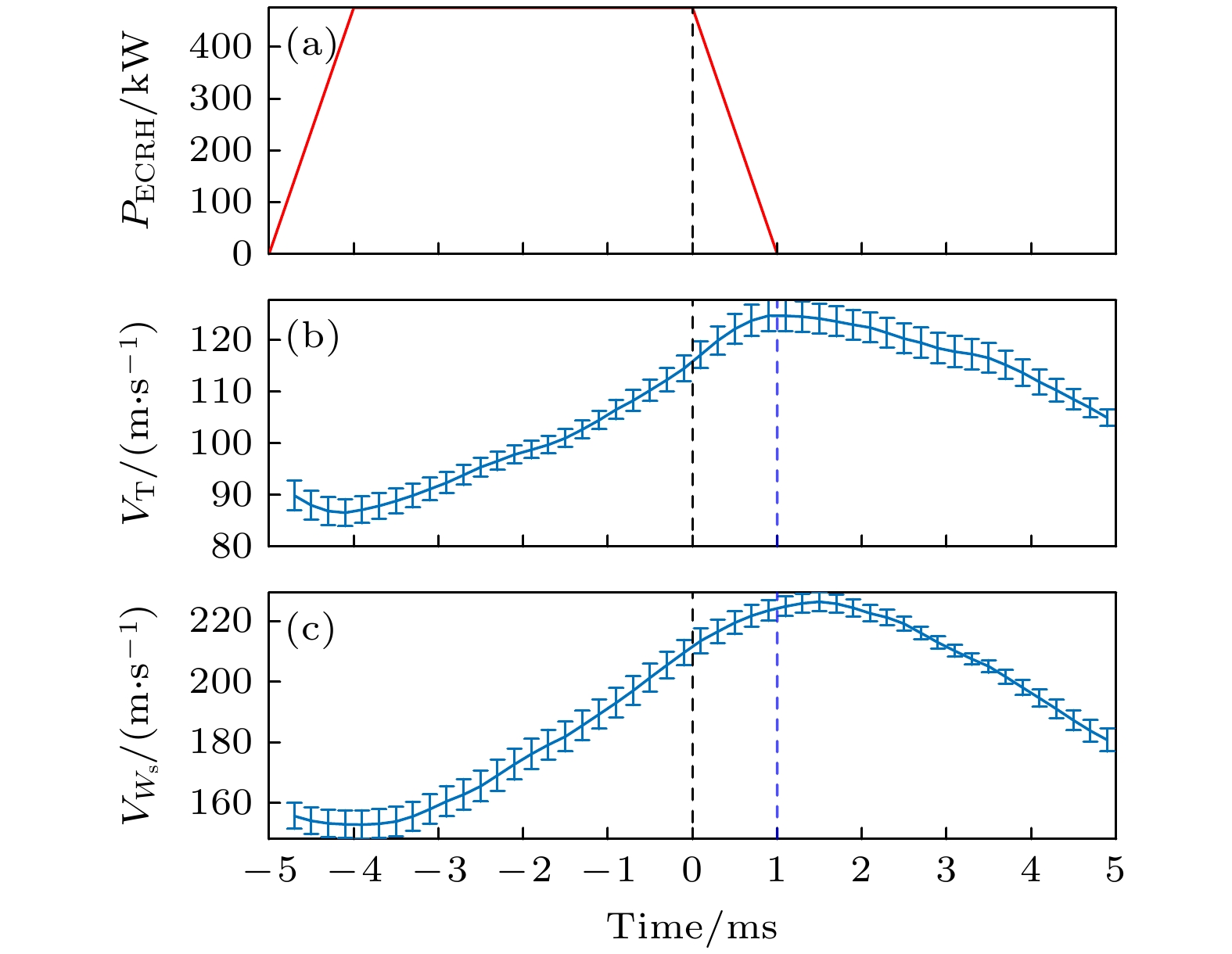-
The plasma flow generated by turbulent nonlinear interaction can improve plasma confinement by suppressing turbulence and its driven transport. Turbulence can be driven by local gradients and propagate radially from far beyond its relevant length. Effects of electron cyclotron resonance heating (ECRH) modulation on edge turbulence driving and spreading are observed for the first time in the edge plasma of the HL-2A tokamak. These experiments are performed by a fast reciprocating Langmuir probe array. When ECRH modulation is applied, both the edge temperature and the edge plasma density are higher, and the radial electric field is stronger. The edge radial electric field, turbulence, and Reynolds stresses are all enhanced when the ECRH is applied, while the ion-ion collision rate is reduced. Figures (a)-(g) show the conditional averages of the ECRH power, turbulence intensity, turbulent Reynolds stress gradient, $ {\boldsymbol{E}}_{r}\times \boldsymbol{B} $ poloidal velocity, density gradient, turbulence drive rate and turbulence spreading rate, respectively. With ECRH applied, both the turbulence intensity and the Reynolds stress gradients increase. The maximum turbulence intensity appears at the beginning of the ECRH switch-off while the maximum stress gradient occurs at the end of the ECRH. The evolution of the $ {\boldsymbol{E}}_{r}\times \boldsymbol{B} $ poloidal velocity is very similar to that of the Reynolds stress gradient. This observation suggests that the poloidal flow is the result of the combined effect of turbulence nonlinear driving and damping. The enhancement of Reynolds stress during ECRH modulation mainly depends on the increase of the turbulence intensity, with the increase in radial velocity fluctuation intensity being more significant. The turbulence drive and spreading rates also increase with ECRH. The maximum drive rate appears at the beginning of the ECRH switch-off, while the maximum spreading rate occurs at the end of the ECRH. This analysis indicates that turbulence driving and spreading are enhanced, with the former being dominant. This result suggests that the enhancements of turbulence driving and spreading lead the turbulence and Reynolds stress to increase, and thus producing the stronger edge flows.
-
Keywords:
- tokamak /
- electron cyclotron resonance heating modulation /
- edge flow and turbulence /
- Langmuir probes
-
图 2 等离子体参数的时间演化 (a) ECRH功率; (b)环向磁场强度$ {B}_{{\mathrm{t}}}; $ (c)等离子体电流$ {I}_{{\mathrm{p}}}; $ (d)线平均电子密度$ \left\langle{{N}_{{\mathrm{e}}}}\right\rangle; $ (e)探针位移
Figure 2. Time evolutions of plasma parameters: (a) ECRH power, (b) toroidal magnetic field $ {B}_{{\mathrm{t}}} $, (c) plasma current $ {I}_{{\mathrm{p}}} $, (d) line-averaged electronic density $ \left\langle{{N}_{{\mathrm{e}}}}\right\rangle $; (e) probe displacement.
图 5 (a) ECRH功率, (b)压强梯度$ {\nabla P}_{{\mathrm{e}}}/{en}_{{\mathrm{e}}}{Z}_{{\mathrm{i}}} $和(c)极向流$ -{v}_{{\mathrm{\theta }}}{B}_{{\mathrm{t}}} $贡献的径向电场, (d)径向电场$ {E}_{{\mathrm{r}}} $, (e)悬浮电位涨落(虚线)以及其时频图和(f)离子-离子碰撞率的时间演化
Figure 5. Time evolutions of (a) ECRH power, contributions of (b) pressure gradient $ {\nabla P}_{{\mathrm{e}}}/({en}_{{\mathrm{e}}}{Z}_{{\mathrm{i}}}) $ and (c) poloidal flows ($ -{v}_{{\mathrm{\theta }}}{B}_{{\mathrm{t}}} $) to the radial electric field, (d) radial electric field, (e) floating potential fluctuation (dash line) and its spectrogram and (e) ion-ion collision rate.
图 7 (a) ECRH功率, (b)雷诺协强(Rs), (c)极向速度涨落, (d)径向速度涨落, 径向和极向速度涨落的(e)相位差, 及其(f)相关系数的条件平均
Figure 7. Conditional averages of (a) ECRH power, (b) Reynolds stress (Rs) , (c) poloidal velocity fluctuation, (d) radial velocity fluctuation, (e) the phase difference between the radial and poloidal velocity fluctuations, and (f) their coherencies.
图 8 (a) ECRH功率, (b)密度的梯度, (c)湍流驱动的通量, (d)湍流驱动率($ {\omega }_{{\mathrm{D}}} $), (e)湍流传播率($ {\omega }_{{\mathrm{s}}} $), (f)湍流传播的通量和(g)密度涨落的平方的变化的条件平均
Figure 8. Conditional averages of (a) ECRH power, (b) density gradient, (c) turbulent driven flux, (d) turbulence drive $ {\mathrm{r}}{\mathrm{a}}{\mathrm{t}}{\mathrm{e}}\left({\omega }_{{\mathrm{D}}}\right) $, (e) turbulence spreading $ {\mathrm{r}}{\mathrm{a}}{\mathrm{t}}{\mathrm{e}}\left({\omega }_{{\mathrm{s}}}\right) $, (f) turbulent spreading flux, and (g) square of fluctuation intensity.
-
[1] Huang M, Rao J, Li B, Zhou J, Kang Z H, Wang H, Lu B, Xia D H, Wang C, Feng K, Wang M W, Chen G Y, Pu Y N, Lu Z H, Wang J Q, Duan X R, Liu Y 2012 EPJ Web Conf. 32 04012
 Google Scholar
Google Scholar
[2] Xu H D, Wang X J, Zhang J, Liu F K, Huang Y Y, Shan J F, Xu W Y, Li M H, Lohr J, Gorelov Y A, Anderson J P, Zhang Y, Wu D J, Hu H C, Yang Y, Feng J Q, Tang Y Y, Li B, Ma W D, Wu Z G, Wang J, Zhang L Y, Guo F, Sun H Z, Yan X S, EAST Team 2019 EPJ Web Conf. 203 04002
 Google Scholar
Google Scholar
[3] Xia D H, Chen X X, Li J T, Wang R M, Zheng W, the J-TEXT team 2024 EPJ Web Conf. 313 02003
 Google Scholar
Google Scholar
[4] Wagner D, Grünwald G, Leuterer F, Manini A, Monaco F, Münich M, Schütz H, Stober J, Zohm H, Franke T, Thumm M, Gantenbein G, Heidinger R, Meier A, Kasparek W, Lechte C, Litvak A, Denisov G G, Chirkov A V, Tai E M, Popov L G, NichiporenkoV O, Myasnikov V E, Solyanova E A, Malygin S A, Meo F, Woskov P 2008 Nucl. Fusion 48 054006
 Google Scholar
Google Scholar
[5] Kubo S 2012 EPJ Web Conf. 32 02001
 Google Scholar
Google Scholar
[6] Kajiwara K, Ikeda Y, Sakamoto K, Kasugai A, Seki M, Moriyama S, Takahashi K, Imai T, Mitsunaka Y, Fujii T 2003 Fusion Eng. Des. 65 493
 Google Scholar
Google Scholar
[7] Gnesin S, Decker J, Coda S, Goodman T P, Peysson Y, Mazon D 2012 Plasma Phys. Control. Fusion 54 035002
 Google Scholar
Google Scholar
[8] Mariani A, Mantica P, Brunner S, Fontana M, Karpushov A, Marini C, Porte L, Sauter O, the TCV Team, the EUROfusion MST1 Team 2019 Nucl. Fusion 59 126017
 Google Scholar
Google Scholar
[9] Yang Z J, Zhang Y P, Ren X H, Li F, Xu X, Yan W, Zhang X Y, Xia D H, Zhang Z C, GaoY, Zha X Q, Luo Q, Chen Z Y, Cheng Z F, Chen Z P, Gao L, Ding Y H 2021 Nucl. Fusion 61 086005
 Google Scholar
Google Scholar
[10] Wang S X, Liu H Q, Jie Y X, Zang Q, Lyu B, Zhang T, Zeng L, Zhang S B, Shi N, Lan T, Zou Z Y, Li W M, Yao Y, Wei X C, Lian H, Li G, Xu H D, Zhang X J, Wu B, Sun Y W, the EAST Team 2016 Plasma Sci. Technol. 19 015102
[11] Baschetti S, Bufferand H, Ciraolo G, Fedorczak N, Ghendrih P, Tamain P, Serre E, the EUROfusion MST1 team, the TCV team 2019 Nucl. Mater. Energy 19 200
 Google Scholar
Google Scholar
[12] Weiland J, Eriksson A, Nordman H, Zagorodny A 2007 Plasma Phys. Control. Fusion 49 A45
 Google Scholar
Google Scholar
[13] Luo L, Rafiq T, Kritz A H 2013 Comput. Phys. Commun. 184 2267
 Google Scholar
Google Scholar
[14] Doyle E J, Houlberg W A, Kamada Y, Mukhovatov V, Osborne T H, Polevoi A, Bateman G, Connor J W, Cordey J G, Fujita T, Garbet X, Hahm T S, Horton L D, Hubbard A E, Imbeaux F, Jenko F, Kinsey J E, Kishimoto Y, Li J, Luce T C, Martin Y, Ossipenko M, Parail V, Peeters A, Rhodes T L, Rice J E, Roach C M, Rozhansky V, Ryter F, Saibene G, Sartori R, Sips A C C, Snipes J A, Sugihara M, Synakowski E J, Takenaga H, Takizuka T, Thomsen K, Wade M R, Wilson H R, ITPA Transport Physics Topical Group, ITPA Confinement Database, Modelling Topical Group, ITPA Pedestal and Edge Topical Group 2007 Nucl. Fusion 47 S18
 Google Scholar
Google Scholar
[15] Ritz C P, Brower D L, Rhodes T L, Bengtson R D, Levinson S J, LuhmannJr N C, Peebles W A, Powers E J 1987 Nucl. Fusion 27 1125
 Google Scholar
Google Scholar
[16] Zhao K J, Dong J Q, Yan L W, Diamond P H, Cheng J, Hong W Y, Huang Z H, Xu M, Tynan G R, Itoh K, Itoh S -I, Fujisawa A, Nagashima Y, Inagaki S, Wang Z X, Wei L, Li Q, Ji X Q, Huang Y, Liu Yi, Zhou J, Song X M, Yang Q W, Ding X T, Duan X R, the HL-2A Team 2013 Nucl. Fusion 53 083011
 Google Scholar
Google Scholar
[17] Grenfell G, Van Milligen B P, Losada U, Ting W, Liu B, Silva C, Spolaore M, Hidalgo C, The TJ-II Team 2018 Nucl. Fusion 59 016018
[18] Gao J M, Cai L Z, Zou X L, Eich T, Adamek J, Cao C Z, Huang Z H, Ji X Q, Jiang M, Liu L, Lu J, Liu Y, Shi Z B, Thornton A J, Wu N, Xiao G L, Xu M, Yan L W, Yu L M, Yu D L, Yang Q W, Zhong W L, the HL-2A Team 2021 Nucl. Fusion 61 066024
 Google Scholar
Google Scholar
[19] Zhao K J, Nagashima Y, Guo Z B, Dong J Q, Yan L W, Itoh K, Itoh S I, Li X B, Li J Q, Fujisawa A, Inagaki S, Cheng J, Xu J Q, Kosuga Y, Sasaki M, Wang Z X, Zhang H Q, Chen Y Q, Cao X G, Yu D L, Liu Y, Song X M, Xia F, Wang S 2022 Plasma Sci. Technol. 25 015101
[20] Zhao K J, Shi Y J, Hahn S H, Diamond P H, Sun Y, Cheng J, Liu H, Lie N, Chen Z P, Ding Y H, Chen Z Y, Rao B, Leconte M, Bak J G, Cheng Z F, Gao L, Zhang X Q, Yang Z J, Wang N C, Wang L, Jin W, Yan L W, Dong J Q, Zhuang G, J-TEXT team 2015 Nucl. Fusion 55 073022
 Google Scholar
Google Scholar
[21] Zhao K J, Chen Z P, Shi Y J, Diamond P H, Dong J Q, Chen Z P, Ding Y H, Zhuang G, Liu Y B, Zhang H Q, Chen Y Q, Liu H, Cheng J, Nie L, Rao B, Cheng Z F, Gao L, Zhang X Q, Yang Z J, Wang N C, Wang L, Li J Q, Jin W, Xu J Q, Yan L W, Liang Y F, Xie Y Y, Liu B 2020 Nucl. Fusion 60 106030
 Google Scholar
Google Scholar
[22] Manz P, Ribeiro T T, Scott B D, Birkenmeier G, Carralero D, Fuchert G, Müller S H, Müller H W, Stroth U, Wolfrum E 2015 Phys. Plasmas 22 022308
 Google Scholar
Google Scholar
[23] Wu T, Diamond P H, Nie L, Xu M, Yu Y, Hong R J, Chen Y H, Xu J Q, Long T, Zhang Y, Yan Q H, Ke R, Cheng J, Li W, Huang Z H, Yan L W, Chu X, Wang Z H, Hidalgo C 2023 Nucl. Fusion 63 126001
 Google Scholar
Google Scholar
[24] Long T, Diamond P H, Ke R, Nie L, Xu M, Zhang X Y, Li B L, Chen Z P, Xu X, Wang Z H, Wu T, Tian W J, Yuan J B , Yuan B D, Gong S B, Xiao C Y , Gao J M, Hao Z G, Wang N C, Chen Z Y, Yang Z J, Gao L, Ding Y H, Pan Y, Chen W, Hao G Z, Li J Q, Zhong W L, Duan X R 2021 Nucl. Fusion 61 126066
Metrics
- Abstract views: 375
- PDF Downloads: 5
- Cited By: 0














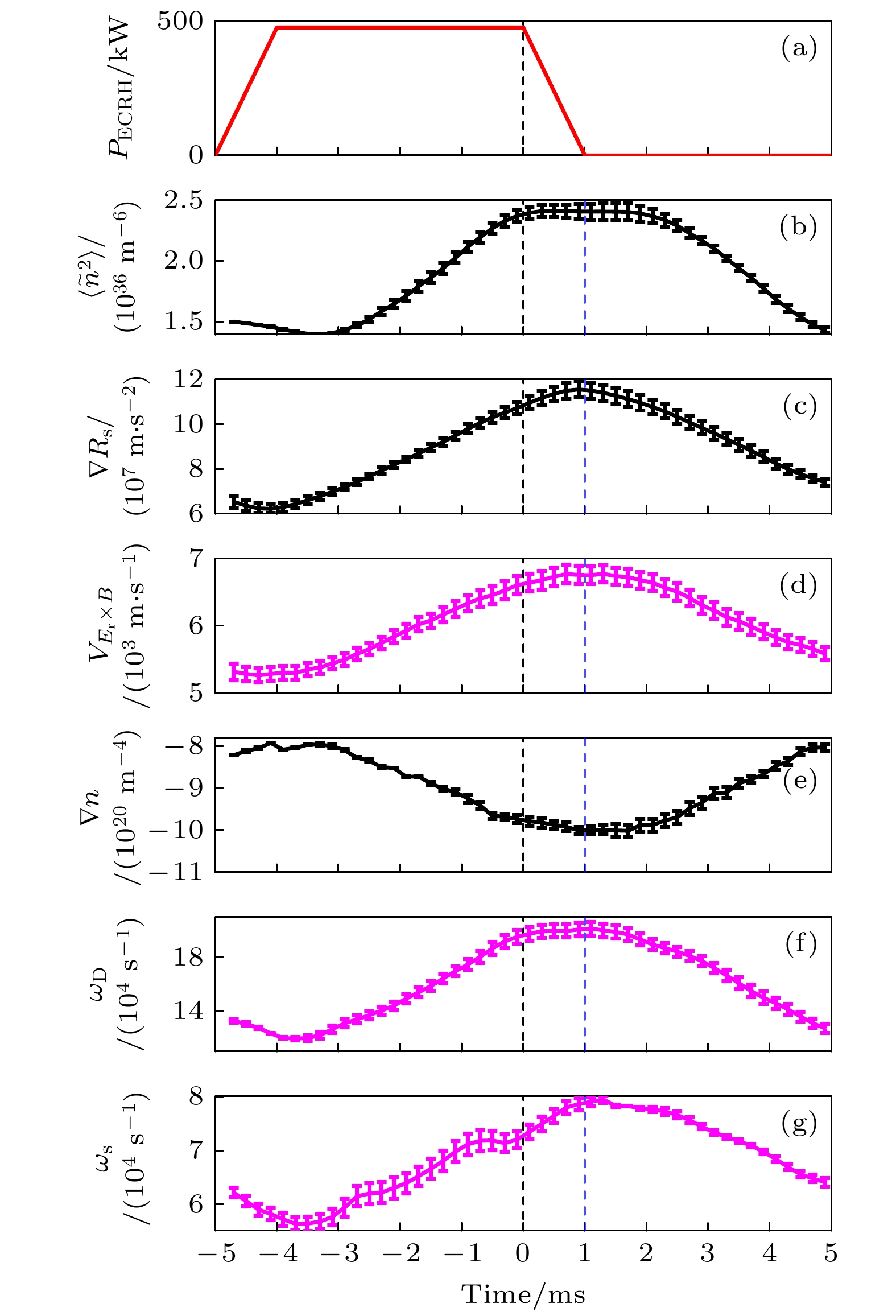

 DownLoad:
DownLoad:
